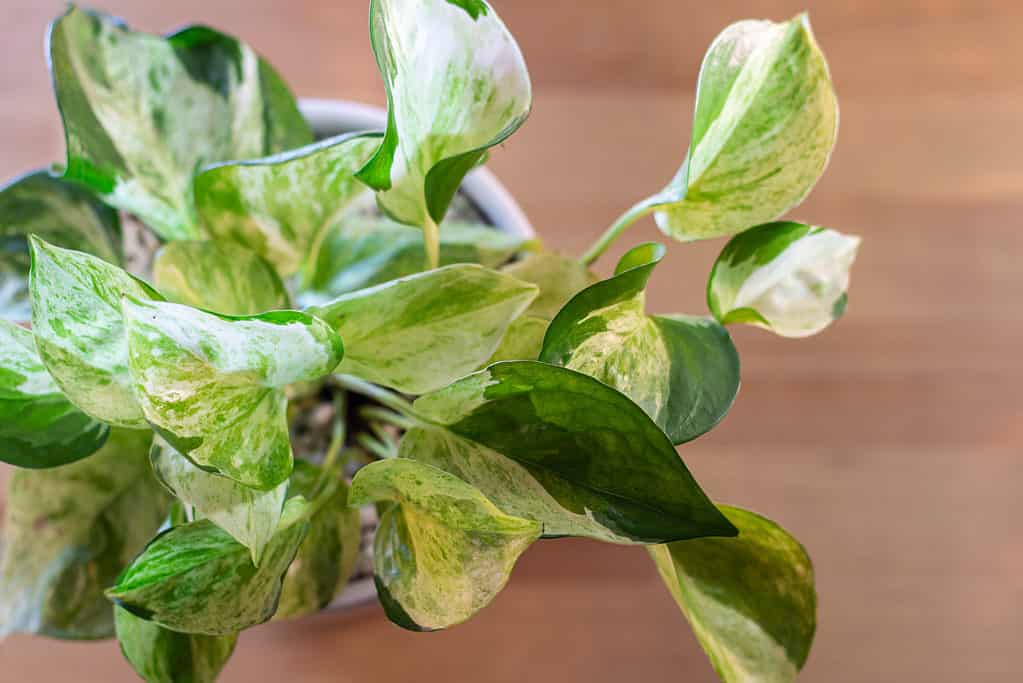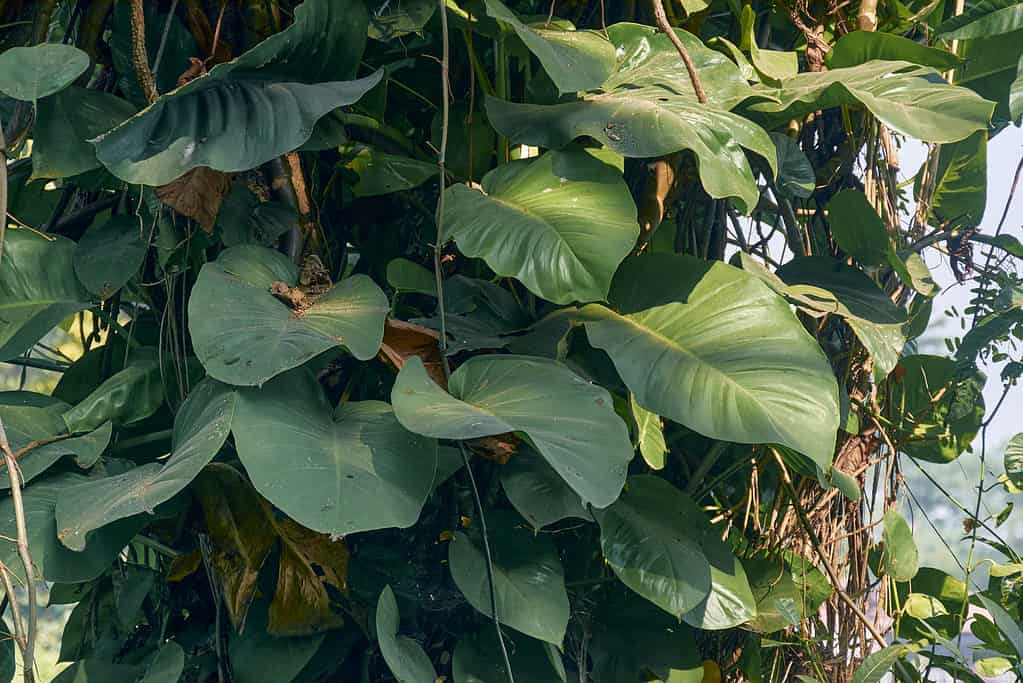One of the more popular varieties of pothos that have been welcomed into homes all across the world in the past few years is the jade pothos. This resilient plant is rather easy to take care of, making it ideal for beginner plant parents.
The jade pothos is the plant for you if you’ve always wanted your house to be covered in lush, green plants but don’t have a ton of time to dedicate to them or many windows in your space. This beloved tropical vine is renowned for purifying interior air and for its long and elegant heart-shaped leaves. This is truly a gratifying and easy home plant to nurture for beginners. It tolerates longer stretches without watering and does well in dim light. The jade pothos, like other pothos plants, lives up to its moniker as “the devil’s ivy” because it is so hardy and challenging to kill from neglect.
The color, size, form, and overall vibe of the jade pothos cultivar make it unique among other cultivars. Even when compared to some of the most well-known pothos types, it has grown rather popular and can be found in local nurseries around the globe.
If you want to grow your very own jade pothos, we’ll break down the basics of this plant’s care as well as some vital facts about this stunner of a houseplant.
What are Jade Pothos?
The jade pothos is one of several varieties of pothos that you can easily purchase at garden centers, as it is not extremely rare. It is a naturally occurring mutation of the original golden pothos, and it has thick, dark, bright green leaves, robust stems, and an increased tolerance to dryness. These hardy vining plants, which look beautiful in hanging baskets or on shelves, can tolerate different lighting levels as well. In comparison to their relative, the golden pothos, these plants have narrower, deeper forest green leaves. They have been developed to only be extremely robust and dark green.
Jade pothos is scientifically referred to as Epipremnum aureum ‘Jade’. The maximum size of this perennial vine is a whopping 40 feet long and six feet broad. The jade pothos, a South Pacific native, can live both inside and outdoors in USDA hardiness zones 10 through 12.
The jade pothos is one of the earliest pothos cultivars to be domesticated from its wild equivalents in French Polynesia, Australia, and Asia, according to some plant enthusiasts. Common jade pothos are among the strongest types of pothos, with bigger leaves, sturdy stems, and drought resistance, which can also be attributed to these genetics. Since they have more chlorophyll than their more variegated cousin cultivars, such plants with dark colors are also better at photosynthesizing. This indicates that they are more tolerant to a range of light intensities. Remember, that doesn’t imply you should completely disregard them. While tolerant of neglect, the jade pothos does need some care to thrive.
How to Identify a Jade Pothos
The jade pothos cultivar is known for its extremely glossy, variegation-free leaves. It is not a real jade pothos if the leaves have any variegation. Variegation refers to stripes or spots of different colors on a plant’s foliage. Simply look for the most basic, pure green leaves to identify a jade pothos among its cousins.
This cultivar can often be confused with its relative, the Manjula pothos. While they are closely related, the jade and Manjula pothos are noticeably distinct. The Manjula pothos is ornamented with a stunning marbling of chartreuse, dark green, and creamy white streaks of color, earning it the nickname “the gem of the pothos genus.” This is plainly in stark contrast to the elegant simplicity of the jade pothos. Compared to the Manjula pothos, this plant has stronger, more vivacious vines.
The stark variegation and albino-like patches on the leaves of the Manjula pothos also contribute to its lower chlorophyll content. This can occasionally have an impact on the plant’s growth habits and tolerance for extremely dim indoor lighting. Jade pothos plants appreciate all types of lighting, from bright to dim, and even bathrooms with little windows that are barely illuminated. Manjula pothos, on the other hand, unquestionably needs more continuous indirect sunshine. The white variegation of the Manjula will fade in too much light and will struggle to develop as swiftly as the jade pothos in too much darkness.

Manjula pothos (pictured) are variegated, while jade pothos are not.
©Catherine Tribone/Shutterstock.com
How to Care for Jade Pothos
The jade pothos is forgiving of neglect like the majority of other pothos types are. No matter the lighting, you should be able to grow it in the majority of your home’s rooms. You can let it grow along a shelf or climb a trellis. The vines can grow up to 40 feet long if left unchecked, so gently shaking them occasionally helps keep them from entwining into a tangled mess of leaves and vines.
Your jade pothos doesn’t require much upkeep in terms of watering. Overwatering is one of the main causes of this tough plant’s deterioration. Thus, you should never let your jade pothos stand in soggy soil for too long. Be careful to remove any remaining water from a run-off dish beneath the pot right away if there is any left after irrigation.
Particularly in low-light situations, this drought-resistant cultivar prefers for the top few inches of soil to completely dry out in between waterings. If you’re unclear about when to water, watch for the first signs of wilting leaves. You might only need to water once per week in the summer and much less in the winter. As always, you can simply stick a finger in the soil to detect if it is dry or wet in order to determine if the plant needs water.
Jade pothos does well in a variety of lighting situations, and some people even grow it in workplaces that use artificial, fluorescent lighting, despite the fact that it likes bright, indirect light. If you place your jade pothos in a significantly sunny area, just be aware of the potential for burned leaves. A healthy plant with lush foliage is more likely to grow when placed on a north-facing window sill or in the center of a space with a south-facing window.
While gorgeous, this cultivar lacks some of other pothos varieties’ eye-catching leaf variegation. Despite this, its solid-colored leaves offer a larger capacity for photosynthetic energy, making it an excellent choice if sunlight is scarcer where you live. For variegated cultivars, a lack of sunlight can result in fading variegation. If you don’t have a ton of sun, the jade pothos is perfect for you!
Most potting soils work well for the jade pothos as long as the soil is well-draining. Wet roots are one thing this plant won’t like, though. If you have any worries, consider adding perlite, peat moss, or coconut coir to help with drainage. If you choose to put your jade pothos in a decent soil mixture, they aren’t heavy eaters and can live without fertilizer. But, if you want to encourage the healthiest development and the darkest green foliage, you can opt to feed your jade pothos every two months with an organic emulsion or a half-strength, balanced houseplant fertilizer.
Warm environments between 65 and 80 degrees F are ideal for these plants. Temperatures around 60 degrees F are acceptable throughout the winter, but anything below 50 degrees F is problematic for their development.
Jade pothos can usually tolerate typical levels of indoor humidity. These tropical plants can thrive in low-humidity environments despite the fact that they prefer high-humidity environments. Even if the room you choose doesn’t get a lot of light, jade pothos are the ideal plants for damp bathrooms and kitchens. Throughout the winter, just keep these cold-sensitive plants away from drafty windows and air conditioning vents.
The Benefits of Jade Pothos
The jade pothos, as well as most other cultivars of pothos, are well-known leaders in indoor air filtration. These plants were employed in NASA’s research on indoor air pollution and demonstrated a remarkable ability to remove harmful substances like formaldehyde and benzene from indoor air. As indoor air pollution can range from five to 100 times higher than outside air pollution, the presence of plants like pothos that filter the air might be justified for reasons other than aesthetics. To make it easier for you to breathe if you spend a lot of time inside, think about putting some of these plants in your living room, workplace, or bedroom. Just keep in mind that you’ll need to have quite a few pothos plants to reap the benefits of air filtration.

Jade pothos (pictured) have excellent air purification properties in addition to being aesthetically pleasing.
©iStock.com/Suprabhat Dutta
How to Repot a Jade Pothos
Jade pothos prefer to be slightly rootbound in their pots. But occasionally, this plant might grow to the point that it has to be repotted or moved into a bigger pot. When repotting your jade pothos, you might want to give it a better soil mixture that is more organic matter-rich and well-draining.
Ensure sure your pothos has fully rooted out its current container, which means the root ball has reached as far as the pot’s edges and perhaps even become a little bit rootbound. This will guarantee that the majority of the soil will remain affixed to the root ball when you take the roots out to transplant.
Choose a hanging pot or basket that has drainage holes at the bottom and has almost double the capacity of the jade pothos’ current container. Put a good organic potting mix inside that has enough compost and perlite to allow water to drain freely. From there, make a sizable hole in the center of the container using a shovel or your hands. It should be only somewhat bigger than the root ball. Wiggle the plant out of the container while holding it by the base of its stalks.
Once the jade pothos is placed in the new container, backfill the new container with soil. If possible, avoid compacting the dirt or pressing it down. To lessen transplanting stress, water it and keep it in a warm, shaded spot for a few weeks.
Should I Prune My Jade Pothos?
These low-maintenance plants don’t require much trimming. But, if the vines are growing too long for your living area, you might want to prune them in the springtime. It helps to focus energy on the strongest vines and promote new development by removing any yellowing leaves or vines.
What do you think about the jade pothos plant? While many prefer the variegated versions of pothos, this solid green stunner is just as beautiful and would make an excellent addition to any plant collection.
Up Next:
- Pothos Leaves Turning Brown: Why It’s Happening And How To Fix
- Do Pothos Like To Be Root-Bound? Everything You Need To Know
- Growing Indoor Pothos: How To Keep This Plant Happy Inside
The photo featured at the top of this post is © iStock.com/Suprabhat Dutta
Thank you for reading! Have some feedback for us? Contact the AZ Animals editorial team.






